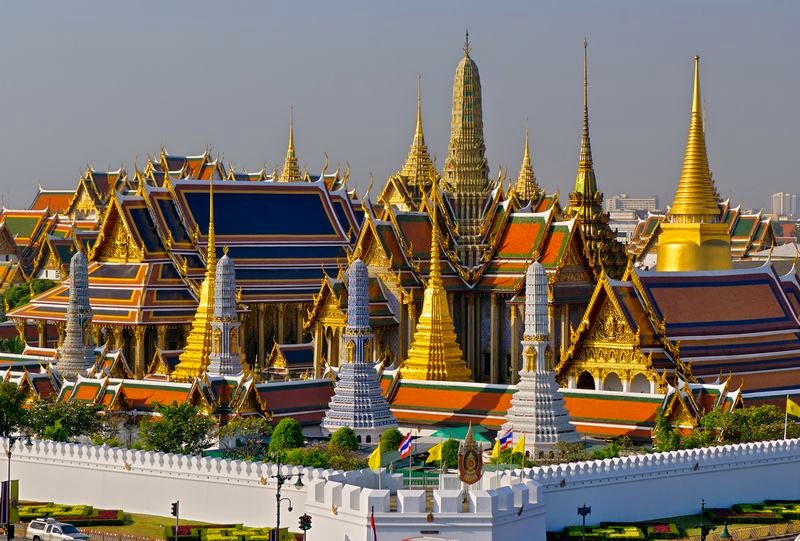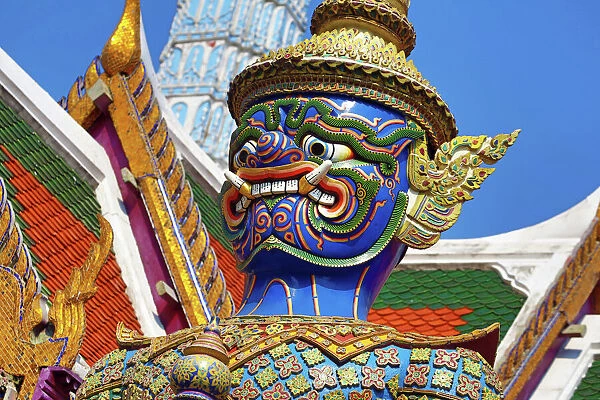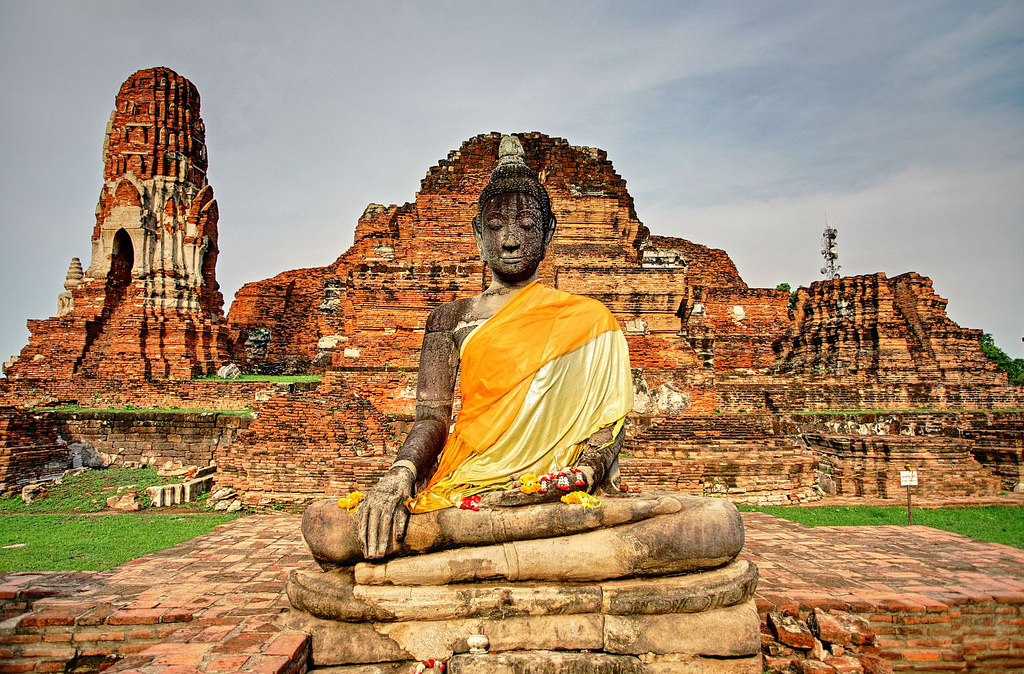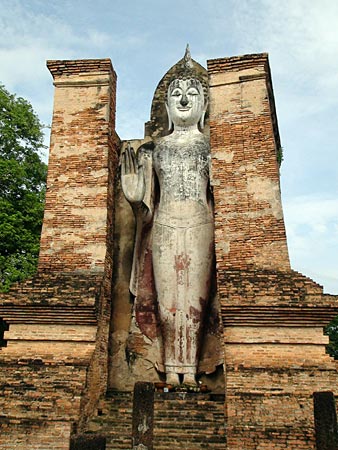THAILAND – Nov 8-11, 23-26, 30-Dec 12, April 9-14
Bangkok and Thailand are the transportation hub of SE Asia, and I travelled through Thai immigration ten times, with a whole lot of stamps on my short-of-space passport. I was in Bangkok for three days in early November to get my Myanmar visa, and then again to see more sights before heading to south Thailand.
Bangkok (pop. 8 million) has something for everyone – high-end shopping, all kinds of accommodation, partying, food, atmospheric neighbourhoods, and culture. Try to stay close to the Sky Train as that is the only reasonable way to travel. Traffic jams are legendary, and along with all the tuk-tuk and taxi rip-offs, they are best avoided. This would rule out the backpacker ghetto of Khao San Road, and I can’t understand why anyone would want to stay there anyway, especially if sleep is on the agenda. On my first 3 days, I stayed at Lub’d in Silom, a modern hostel with some great features, but much bad dorm behaviour. It was a few blocks from the Myanmar Embassy, as my main mission in Bangkok was to get a visa.
Wat Phre Kaew or the Temple of the Emerald Buddha, is an architectural wonder of gleaming gilded stupas, coloured roof tiles, mosaic-encrusted pillars and marble. The revered Emerald Buddha is actually made of jasper and was once hidden under a layer of stucco in northern Thailand, seized by Laos forces and then returned to Bangkok. The temple walls are lined with colourful murals detailing the story.
The Grand Palace, once the home of the Thai Royal family, is on the same grounds. The interiors of the four buildings are closed but the extravagant exterior is a riot of coloured glass and mirror mosaics. The dress code is rigorously enforced – no shorts, sleeveless tops, holes in the knees, or tights, but longhis are available.
As the Palace was closed during lunch, we were taken by our tuk-tuk drivers to a large standing Buddha (Wat Intharawihan), and then to a suit store! Part of the behaviour of these guys, we simply told the salesman that we had no interest in suits.
From the palace, we walked to Wat Pho, the oldest and largest temple in Bangkok, dating from the 16th century. It houses the country’s largest lying Buddha, 46m long and 15m high and covered in gold leaf, signifying the passing of Buddha into final nirvana. Surrounding it are temples with the largest number of Buddha images in the country. With a young guy from Luxembourg, we walked home through Chinatown, getting lost many times in the maze of streets.
That evening, we tried to walk through the Oriental Hotel, built originally by the early Dutch traders. In shorts, we couldn’t get inside the door.
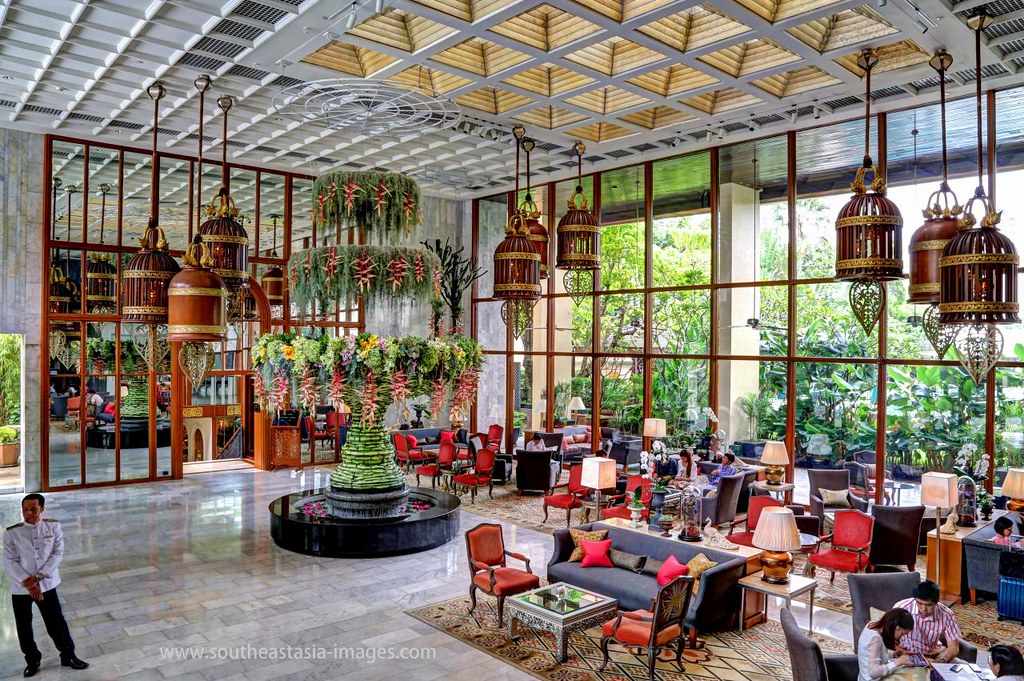
After two weeks in Myanmar, I returned to Bangkok and stayed near the end of the rail line from the airport at Phaya That. The next morning, I took a minibus from the Victory Monument 2 hours north to
AYUTHAYA, the capital of the country from 1350 to 1767 when it was sacked by the Burmese. It was built at the confluence of three rivers forming both a natural barrier to invasion and an invitation to trade. Today the ruins are spread around a modern provincial town. A Unesco World Heritage Site, the ruins on the “island” consist of many brick stupas and a few major sites. Wat Phra Si Sanphet was the site of the royal palace, consisting of three large stupas, surrounded by a maze of adjoining buildings and small stupas, many crumbling and leaning at odd angles. The adjacent Wihaan Phra Mongkhon Bophit houses a huge bronze seated Buddha, damaged over the years by lightning and the roof falling in on it.
At Wat Phra Mahathat, besides the large prang (a towering phallic spire of Khmer origin serving the same function as a stupa), is one of the most iconic images in Ayuthaya, a Buddha’s head engulfed by tentacle-like tree roots.
Outside the island, I visited a recreated floating market, set at the edge of a temple, odd with its combined Hindu and Buddhist images and cement figures and gardens.
Nearby is Wat Chai Wattanaram, easily the prettiest and most photogenic temple in Ayuthaya. Built in 1630, its large central prang is surrounded by 8 large stupas, brick walls and many Buddha images. Mostly intact, the brick inner structures still have large remnants of decorative stucco.
It was then a long bicycle ride and a short ferry to Wat Phanan Choeng containing a 19m high bronze sitting Buddha, which reportedly wept when the Burmese sacked Ayuthaya. This very holy site is always crowded with pilgrims.
After another short ferry ride, I luckily found the bicycle rental place. It was a big day on the bike.
Back in Bangkok, I continued on the Sky Train to Siam, where the very high-end malls of Siam Discovery and Siam Paragon are. Theoretically, the biggest malls in SE Asia would fit in any big European city with all the most expensive brands, a seemingly frivolous venture in this non-first-world country. Who buys this stuff? Locals hang around as if it were an urban park.
The next day, I got up early to a non-air-conditioned lobby and couldn’t bear to spend all day there, so headed back to the Victory Monument to catch a minivan 2 hours west to Kanchanaburi and the Bridge over the River Kwai. Starting in 1942, during the Japanese occupation of Thailand, captured Allied soldiers and Malay conscripts built 415kms of rail linking Thailand and Burma for further conquests in SE Asia. It is known today as the Death Railway as more than 100,000 men lost their lives (80,000 were Malay) in the astonishing 16 months it took to build the line through rough terrain, using rudimentary equipment and harsh working conditions. The bridge was used for 20 months before being eventually destroyed in 1945 by Allied bombers, not by commandos setting bombs in the water, as told in the movie. The nondescript bridge is 300m upstream from the original, and appears nothing like the area or bridge in the movie – no jungle, rapids or boulders – simply a long metal bridge on concrete piers over a languid stretch of water inside the city and surrounded by souvenir shops. I rented a bicycle, walked over the bridge, and visited one of the three Allied cemeteries with mostly British, but also Australians, Dutch and French. Not one of the other labourers has an identifiable grave.
At 11:00 that night, I went with seven 20-somethings to the backpacker ghetto of Khao San Road. The party was in full swing on the 2 block long, pedestrian street. Tables, souvenir shops, and massage couches crowd the street. Music blares at top volume. The party ends at 5 AM, the noise stops, and they sleep the day through and repeat. Despite paying $2 for four in a taxi to arrive, the cost inflated to $10. I’d had enough after an hour. Far from cheap rapid transit, just getting to any reasonable cultural site involves taxis and terrible traffic, so why stay here, unless all you want to do is drink?
Before my flight in the afternoon the next day, the plan was to see the
Jim Thompson House. He was an American architect who settled in Bangkok after the war and developed the Thai silk industry. At the age of 61 in 1967, he travelled to the Cameron Highlands in Malaysia, and disappeared, never to be seen again. He had built the house from salvaged traditional Thai houses, all wood, on the banks of a canal close to my hostel.
I joined the mandatory English tour to see all the glorious buildings, art, Buddha statues and gardens. Well worth it.
On my way back, there was a massive protest march on the street. The big controversy here is whether Thaksin Shinawatra, the exiled ex-prime Minister, would be given amnesty. The crowds were not in favour, to say the least. On one side of the 6-lane street were huge lines of trucks of people waving flags, blowing whistles and trying to be heard over loudspeakers. Going the opposite way were thousands walking and doing the same thing. All the people on the street were giving the victory sign.
It’s always amazing how I can make an adventure out of anything. On Nov. 25th, I flew to Ranong in south Thailand to go diving. I asked at the hostel how to get to the Don Mueng Airport, where most domestic flights leave – “a taxi for $3 or a bus for 60 cents from Victory Monument”, the BTS station just north of my hostel. I asked several taxis on the street but they were all $10. On my way up the escalator at the Sky Train, I thought I would be clever and take the SkyTrain as far north as I could to Mo Chit and buy a ticket for there for $1. On the train, I chickened out and got out at Victory Monument to take the bus, it had at least some guarantees. I went everywhere around the huge circle but the right one and worked up a terrific sweat (which happens in seconds in Bangkok but faster with a pack). I finally boarded Bus #29, which was gloriously air-conditioned and paid my 60 cent fare. Few speak meaningful English in Thailand. The Thai guy next to me on the bus spoke OK and we exchanged the usual pleasantries. I asked if he was going to Don Mueng (and he was with his big roll-on suitcase), but he didn’t have a clue. Oh well. The bus stops right across the road from the terminal, right next to the railway line, at Mo Chit!
I’m getting tired of Lonely Planet. Out of date when printed, my 2011 SE Asia On a Shoestring, is hopeless. Filled with all sorts of extraneous information (everybody books their hotels on Hostelworld, the restaurant info is dated, and word of mouth is the best way to find the best bars), so all I use it for is the Sites, Maps, and Transportation information.
If you want a fix for home fast food, wait till you get through security at Don Mueang. North American heaven – KFC, McDonalds, Burger King, and my recent favourite, Subway – are all there.
After the $100 one-way flight to Ranong on the Thai/Myanmar border, I was met at the airport by the dive tour company, A-One-Diving, to spend five days on a live-aboard boat. I had wanted to go to the Surin and Similan Marine National Parks in Thailand but there were no trips there, so instead I returned to Myanmar for the Mergui Archipelago trip, in the islands right at the south end of Myanmar. The Myanmar city here is Kawthaung. With 5 Germans, one Brit (who spoke German), and a Japanese fellow, we boarded the boat, and spent all that morning getting another Myanmar visa and paying a $120 royalty fee.
These people spend all their holidays diving. The British guy had the least experience with 85 dives and the rest were in the i00-500 dive range. My skimpy 15 dives looked meagre.
After 6 dives over 2 days, it became apparent that A-1-Diving is not operating a safe operation. As an inexperienced diver, I would not have known any better, but our experienced fellow divers were much more aware. There was no tour of the boat. When the emergency supplies were checked, the oxygen was not connected and it took half an hour to get the set-up correct, not cool if there were an emergency. Everyone else had a dive computer, but I was not given one, and even one of the two guides’ computers was not working. A dive computer is an absolute must especially as we’re doing 16 dives over 5 days. It is best to do your deepest dive at the first of the day and then to stay above 18m to avoid decompression problems. We were diving to 30m several times a day. Four dives per day is a lot. Many were flying the day following the last dive and were anticipating not being able to dive at all the last day.
One of the guides spoke poor English but he was the one who gave all the pre-dive briefings. He paid little attention to his group and they were basically on their own. This was no big problem for these very experienced divers, but a real issue for me. I would only go with the second guide who was very attentive and looked after me well.
A major problem with my diving is that I use up my air rapidly, but the other divers were more than willing to give advice and help me. On this trip alone, I was to do more dives than all the dives I had done previously. My downtime has improved considerably.
The diving initially was mediocre with little hard coral and few fish. We saw many eels including freaky giant morays more than 2m long, scorpionfish and lion fish. Fishermen who fish using dynamite were frequent and it was not uncommon to see the rocks littered with dead fish. No wonder there are few fish and no sharks or mantas.
A particularly disagreeable problem throughout SE Asia is the Chinese desire for live fish. A target is the Napolean Wrasse, one of the largest and most docile fish in the reef. The Chinese believe that this species when eaten live will improve virility, and the lips are supposedly an aphrodisiac. The fish are stunned with sodium cyanide, caught, held in live pens and sold live, in 1995 for $2-300 per kilo, and more for the lips. In one Shanghai restaurant visited by one of the divers, the speciality is to freeze the head in liquid nitrogen and cook the body. As the head unfreezes, it still quivers as if alive – again like eating living fish.
So much money is involved that policing the problem is impossible for these poor fishermen. Does this sound familiar? The Chinese penchant for raping the wildlife of the world for their rhinoceros horn, bear gall bladders, turtles and other assorted exotic animal parts, is destroying our planet. Harvesting shark fins (to produce a tasteless soup viewed as a sign of wealth) is criminal. My son is married to a Chinese girl and they had shark fin soup at the wedding!! I had a hard time controlling myself. One of the divers is frequently on business in China and Hong Kong. He regularly asks what is on the menu, and simply refuses to eat anything endangered. Virtually everything but the vegetables, noodles and rice is endangered. They prefer these rare species because they make them “strong”. It is not about being polite but making a statement – to my mind the way to behave. International criticism seems to emphasize human rights, how they treat political dissidents, and their work culture – but this wildlife thing is easily as important.
The Chinese are not the only bad actors. Japanese fishing fleets are raping the oceans with their huge refrigerator fleets. The Sea of Cortez was emptied of fish by Japanese longliners. Japan, Norway, and the Faroe Islands continue to whale. Spain and Portugal have big fishing fleets. The commercial fishery around the world has collapsed in many places. Look at Canada – the cod fishery on the east coast is non-existent. At one time, cod could be scooped out with baskets on the Grand Banks. The West Coast salmon fishery is in peril. Alaska has totally depleted the king crab.
On our third day, farther out from the mainland, we had several spectacular dives, especially at a site called OK Rock. Large schools of fish, many more species, boxer shrimp, nudibranchs, many kinds of stars (including the coral destroying crown of thorns stars), lobster, crays, cuttlefish, and sea snakes were seen. It was interesting diving with the German gay couple who had a good camera. They moved very little examining every crevice and saw much more. It was great to look at her pictures at the end of the dive – a good photographer adds a lot to a trip. We saw three large cuttlefish. The male, in the process of copulating, had a brilliant blue fringe waving in the water. The third was patiently waiting for her turn.
Most of my fellow diver’s lives revolve around diving. The two girls have been diving 22 times in Egypt and have never seen the pyramids. The Japanese man is in SE Asia for 6 days and is only diving.
Diving from a live-aboard with experienced divers willing to share their knowledge is surely the only good way to improve one’s diving. I am slowly extending my dive times by lessening my weights, descending more slowly and equilibrating in a more controlled fashion, moving as little as possible, exploring the nooks and crannies to find the more obscure critters, not using my arms, and simply feeling more controlled underwater thus breathing more shallowly. With so many dives, my shorter dive times are becoming an advantage. I am completely dependent on those with dive computers. It would be virtually impossible to keep track of depths, durations, the accumulative effects of repetitive dives, and the rest times necessary before flying or even going to significant altitudes after finishing a trip. A dive computer is a fundamental necessity.
The boat is crewed completely by Myanmar people. The four guys who help us before and after the dive are unbelievably attentive – zipping up your wet suit, helping with the BCD, helping us with our swim fins. The cook, the only woman on board prepares wonderful, nutritious meals. All these people understand no English but have ready smiles and great attitudes. One of the two guides is of questionable quality. He seems to pay little attention to the depth of dives, downtime, and the effect of repetitive dives (again 4x/day is a lot of diving). The head guide seems to be on his own and I will only dive with the other fellow, who recognizes my inexperience and is very attentive.
On day four, I had a disastrous first dive. We were over a pinnacle, the top of which was at 15m. Because of the current, we were doing a negative entry. That is, there was no stop at the surface and you simply descend immediately. In the excitement, I forgot to put my regulator in my mouth! I followed my favourite guide who followed the other guy, and we were soon at 27m, far too deep. I looked up and all the experienced divers were well above me. I ascended to their level. One of the divers suggested I follow him. I stopped paying attention to my depth gauge (as did he) and we were soon at the surface, that is we had no decompression time, usually 3-5 minutes at 5m. All are very dangerous and unsafe. The lesson I learned was that you are completely responsible for yourself and shouldn’t necessarily depend on anyone. A few divers suggested that I skip the next dive, which I did. I snorkelled around part of the rock and saw some fish, but returned to the boat after about 10 minutes. Again, without a dive computer, I am completely lost and unsafe. Another small point is that when diving deeper, you should add weight to your belt. This will give more control on the ascent. Wearing a neoprene wet suit requires more weight than when not wearing one, and a full-length one is more weight than a shorty.
On day 3, Claudia had her 100th dive, and we celebrated by drinking a bottle of sparkling wine underwater and taking many photos. Only bubbly stuff works as seawater is kept out of the bottle. On day 4, Andre had his 100th, and he drank beer. This is a very collegial group, as almost all younger Germans are a joy to be around. The last dive on day 4 was rather mundane, with a sand desert and a few rocks. Just before it ended, I saw an unusual fish, about a foot long, deep black with large white circles. None of the guides or other divers had ever seen it before and it was not in any of our books.
On our last day, the first dive around an isolated rock was spectacular. The variety and colour of the anemones, hard and soft coral was wondrous. Right at the end, a large lionfish was swimming – completely spread out showing all his spines. A foot away was a giant moray. Very nice. I stayed down as long as anyone and am feeling very comfortable in the water.
I have just realized that diving is probably excluded from my routine travel insurance. As the nearest decompression chambers are in Bangkok and Phuket, helicopter evacuation and hospital care would be inordinately expensive. I need to buy proper dive insurance. They are also more familiar with diving problems and can conduct an evacuation better and ensure the best treatment.
We have seen amazing terrain – rocky islands with karst, big cliffs, isolated rocks in the middle of nowhere, lush forests, and idyllic beaches. On the third night, we were moored off the Andaman resort on an isolated beach. We had a look around, but the high cost, expensive diving, and really nothing to do did not sound inviting to me. On day 4, we stopped at a village and had a chance to look closely at the fishing boats and going on in the village. These are economically very poor communities. As we go farther from the mainland, the diving has improved, as the fish boats could only be out for 2-3 weeks, the limit of their ice. We do not infrequently hear dynamite underwater. Many of the reefs are strewn with huge nets, metal cogs, plastic, ropes and lines. Nobody has seen a shark or a ray – a testament to the appetite for these fish. 90% of the world’s sharks are gone. Again, the international community needs to be more engaged about the state of our oceans. Coral is disappearing everywhere because of global warming, acidification of the water, and the effect of violent cyclones and tsunamis.
The second dive on the last day, and the last of the trip, was mediocre. The large rock was completely covered in stranded fishing nets and lines. Above 12m, there was nothing. All the coral and sea fans were fractured. We saw few anemones or fish. I had a shower, shaved and packed my bag for the 5-hour trip back to the mainland to collect our passports and clear Myanmar immigration.
After talking to experienced divers who have been all over the world comparing the Mergui Archipelago to other places, they thought it very average. Of the 16 dives, only about three sites were excellent. The absence of big fish and small things like nudibranchs was a big negative. The anemones and the variety of anemone fish at the site on our last day were some of the best they have ever seen. A significant plus is the lack of other divers – we saw no one else during our five days. The crew, cook and food on the boat were all special and very attentive. The Myanmar guide who looked after me so well was also appreciated. Certainly, my diving reached a new level.
After a night in Ranong, I took a bus 6 hours south to Krabi, on the west coast of Thailand south of Phuket. As we approached Krabi, the karst landscape started – mountains, cliffs, and pinnacles of large white/yellow walls with dark water streaking. Krabi’s limestone crags come to a dramatic climax at Railay, known for its rock climbing. Longtail boats collect groups of at least eight at the pier on the water, starting at about 9 AM. For 150 baht, they take 45 minutes to reach the main beach. Walk through the maze of resorts to the beach on the other side to swim and catch some rays (bring a bathing suit and towel). One can then walk around the limestone cliff to the east to access the main climbing area. With nearly 500 bolted routes, there is something for everyone. I watched several novices struggle up some of the easy routes with large jug handle holds but had little inclination to join them. The karst cliffs are amazing to see – caves and large draperies of eroded karst festooned on the walls. When I returned it was low tide and a big walk out to the boats moored in the shallows.
There are many other sites accessible from Krabi. As I have little interest in sitting on the beach and have had my fill of diving, for partying and sun lovers, they all could be worthwhile. Ko Phi-Phi has great beaches and limestone and is very touristy since “The Beach” was shot here. Ko Lanta is the largest of the 50 or so islands in the local archipelago but is relatively flat without the karst formations. There are many dive and snorkel locations.
North of Krabi is Phuket, an island that doesn’t feel like an island as it is so huge. Its main town is on the west coast at Patong, and the area has become home to the luxury crowd, now mostly Russians, a tourist to be avoided. After the tsunami destroyed the town, it has been totally rebuilt in a grander style. Further north yet is Ko Chang near Ranong. On the southern Gulf of Thailand is Ko Pha-Ngan, home to the massive full moon party and a favourite backpacker idyll. The party continues all month or people head slightly north to Ko Tao, often to dive.
Some observations: The party scene for 20-somethings is an institution in south Thailand. I am staying in a beautiful hostel in Krabi called Pak-Up – large beds with big, secure lockers, lots of room and a busy staff who look after all one’s travel needs. Two nights ago, my room was empty until 3:30 am when it filled up completely. Thankfully they were quite respectful and quiet. When I got up at 5:30 am this morning, three youngsters were brushing their teeth, and getting ready for bed. I just laughed when they said they had just got up. This is how they spend every night, then sleep in till the late morning, ready to exercise their livers again the next evening. I would think it would get tiring dealing with the perpetual hangover, but their stamina is to admired. South Thailand is one of the great party destinations of the world.
My motto of avoiding anyone over 50 was broken in Myanmar when I travelled briefly with a few aging folks. I cannot imagine a more self-centred lot with such poor conversational skills. They pay little attention to what you have to say and never pursue your line of conversation. Instead, there is an immediate segue back to themselves, and usually, it is personal and on the boring side. I try to always investigate others’ interests, rarely dominate the conversation and only segue into what I think might be interesting and add to the interaction. Why talk about yourself? Surely the interest must be in finding out how others travel or view the world.
Riots have broken out in Bangkok and several have died. Those opposed to the return of Thaksin Shinawatra, the yellow shirts, want his sister, the present prime minister, to step down and are battling those who support it, the red shirts. The red shirts are the rural and/or poor, the majority of the population, and another election would not change the government. Negotiations settled most of the unrest by December 5, the king’s birthday. When this guy dies, there will be a pile of pictures, most large and in elaborate gold frames, to get rid of. His son, now in his late 50s, is not nearly as popular.
Thailand is a modern, progressive-looking country that superficially has the appearance of a first-world state. Bangkok’s shopping malls are first-world. The highways are modern and devoid of potholes. Even the second-class buses are comfortable and air-conditioned. 7-11 stores are ubiquitous, and in Bangkok, there must be one on every block. The south is tropical with palm oil plantations, palms and luxuriant jungle. North of Bangkok, the landscape is completely flat with trees and fields. Treed mountains appear around Chiang Mai and extend to the borders of all the surrounding countries.
The climate gets cooler the farther north one goes, but the real difference is the significant drop in humidity. Chiang Mai, Pai, and Chiang Rai are quite comfortable places to be in the winter. The warmest months are March and April and sounds like a real test. The winter monsoon is active in November/December in south Thailand and it rains most days, usually in the afternoon.
After talking to an American Peace Corps worker here in Thailand for 27 months, it is apparent the public education system is a mess, especially in rural Thailand. School is cancelled for any reason. All the teachers will leave for several days to attend a funeral, for example, or if a VIP is visiting a school, 2 weeks will be totally spent preparing a parade and no classroom work is done. Preparation for a sports day may take a few weeks and again actual education is forgotten. Teaching is by rote memorizing and creative thinking is unknown. He was expected by the teacher to do all the teaching but he viewed his job as one of teaching the teacher.
I took the day off before the long night bus back to Bangkok, arriving at the south bus terminal at 5 AM. This was a VIP bus which allowed a good nights sleep in the wide fully reclining seats. Rather than a taxi, I found the city bus, #28, that travelled directly to the north bus terminal for 50 cents. It was then another 7-hour bus ride to New Sukhothai, where I stayed for two nights. The ruins at Old Sukhothai are a Unesco World Heritage Site and have been described as a mini version of Angkor Wat in Cambodia. Sukhothai emerged as the Khmer empire was crumbling in the 13th century, and subsequently ruled over parts of the empire’s western frontier for 150 years. The kingdom took artistic inspiration from its former overseers building a city of temples with gravity-warped basalt columns, prangs, stupas, serene Buddha figures and weed-sprouting towers. Although Ayuthaya has a more interesting historical narrative, Sukhothai’s ancient city is better preserved and architecturally more engaging.
I stayed in the modern town of New Sukhothai and took the truck taxi 12 km to the site. With three young Europeans, we rented bicycles, necessary to see everything. The central area comprises most of the ancient kingdom and is surrounded by three concentric ramparts and two moats, bridged by four gateways – important celestial geometry. Inside the old walls are the remains of 21 well-preserved historical buildings. Outside in the northern zone is an impressive 15m-high brick and stucco seated Buddha with elegant, tapered fingers. In the western zone are many relatively featureless ruins but a 12.5m high standing Buddha on the crest of a hill with good views. The layout amidst ponds, lakes and old trees took most of the day to explore.
CHAING MAI (pop. 200,000). The next day (Dec. 6) was another 7-hour bus ride north to Chaing Mai. I stayed in the old city, a neat square surrounded by a moat and remnants of a medieval-style wall built 700 years ago to repel Burmese invaders. The maze of streets has hundreds of hotels, guest houses and hostels plus many bars and nightclubs. Western food is everywhere. This place has the highest concentration of tourists in Thailand, including many older Caucasian men with young Thai women. With small first-world pensions, it is a cheap place to live well – the security offered by these older men must be attractive to these women. They also must have a different cultural outlook than Western women. Known as the sex-tourism capital of SE Asia, I have read that the incidence of HIV in the sex trade workers is very high.
Chiang Mai is ripe for tourists with a dizzying variety of adventure tourism – rafting, kayaking, mountain biking, riding elephants, butterfly farms, tiger interactions (the animals are drugged), zip lines, and trekking through hill-tribe villages. These latter experiences are not appealing to me. These people must be tired of tourists traipsing through their villages and homes (how would you feel if a bunch of rural Thai farmers were in your town daily, peering at everything you do, asking the same silly questions, and then asking to come into your house – I’m sure our culture is just as curious to them as theirs is to ours). Cooking classes are common, and Thai massage businesses are every second storefront. The majority of tourists here are on short 1-3 week holidays from work and money is not an object. The costs of most tours are quite high.
I spent a few hours visiting all the Wats (temples) in the Old City. Dragons with long tails flank all entrances and form the gables of the roofs. Several were built in the 13th and 14th centuries and contain a variety of unique Buddha images. We also went to Muay Thai Boxing one night. It was a lot of kicking and clenching and actual boxing was minimal. The small crowd were all tourists.
The Elephant Nature Park is a must-see experience. This is a sanctuary for elephants rescued from logging operations (it was outlawed in 1989) and tourist begging. Several are blind as it is easier to handle blind elephants. One had a deformed back and leg from logging accidents. One had a damaged leg from a land mine. Instead of using picks to control them, the Burmese mahouts use behaviour modification using food. None are chained as in the operations where riding is allowed and they all roam freely. Interactions are intimate – the tourists feed them huge baskets of fruit and melons by hand, bathe them in the river running through the sanctuary, watch them devour several banana trees, pose with them for pictures, pet them and feed them again. All a great experience and much more rewarding than the other elephant operations. In 1900, there were 100,000 elephants in Thailand, now there are 3,000, of which only 1,500 are wild.

Ladyboys are a common minority in Chiang Mai – the part owner of the hostel I stayed in, the guide for the Elephant Nature Park, and all the bartenders at the Muay Thai Boxing. Homosexuality is frowned on but male transvestites (almost assuredly gay also) are accepted as part of society, although they never hold government jobs. Female transvestites are called tom-boys and have close-cropped hair and multiple tattoos.
CHIANG RAI. From Chiang Mai, many tourists go to Pai, and all seem to have found it engaging. Instead, I headed NE to Chiang Rai, close to the Laos border. Instead of a direct bus, I caught the four-hour 7:20 AM bus to Thaton and then the longtail boat that leaves daily at 12:30 for Chiang Rai. Great skill was required by the driver of the boat as the water was low and several small rapids and bridges were negotiated. Views were average and we stopped at the obligatory handicraft store instead of the advertised ethnic village. When I arrived, there were no tuk-tuks or taxis and it was a long walk-about to finally find the Fun-D Hostel, another well-designed, modern hostel.
The best way to see all the sites around Chiang Rai is on tour and I would highly recommend Joe from the hostel. He speaks great English and is a very personable guy. The
White Temple is not to be missed. Construction started in 1997 and continues today under the guidance of a Thai artist who obviously made pockets of money in the USA.
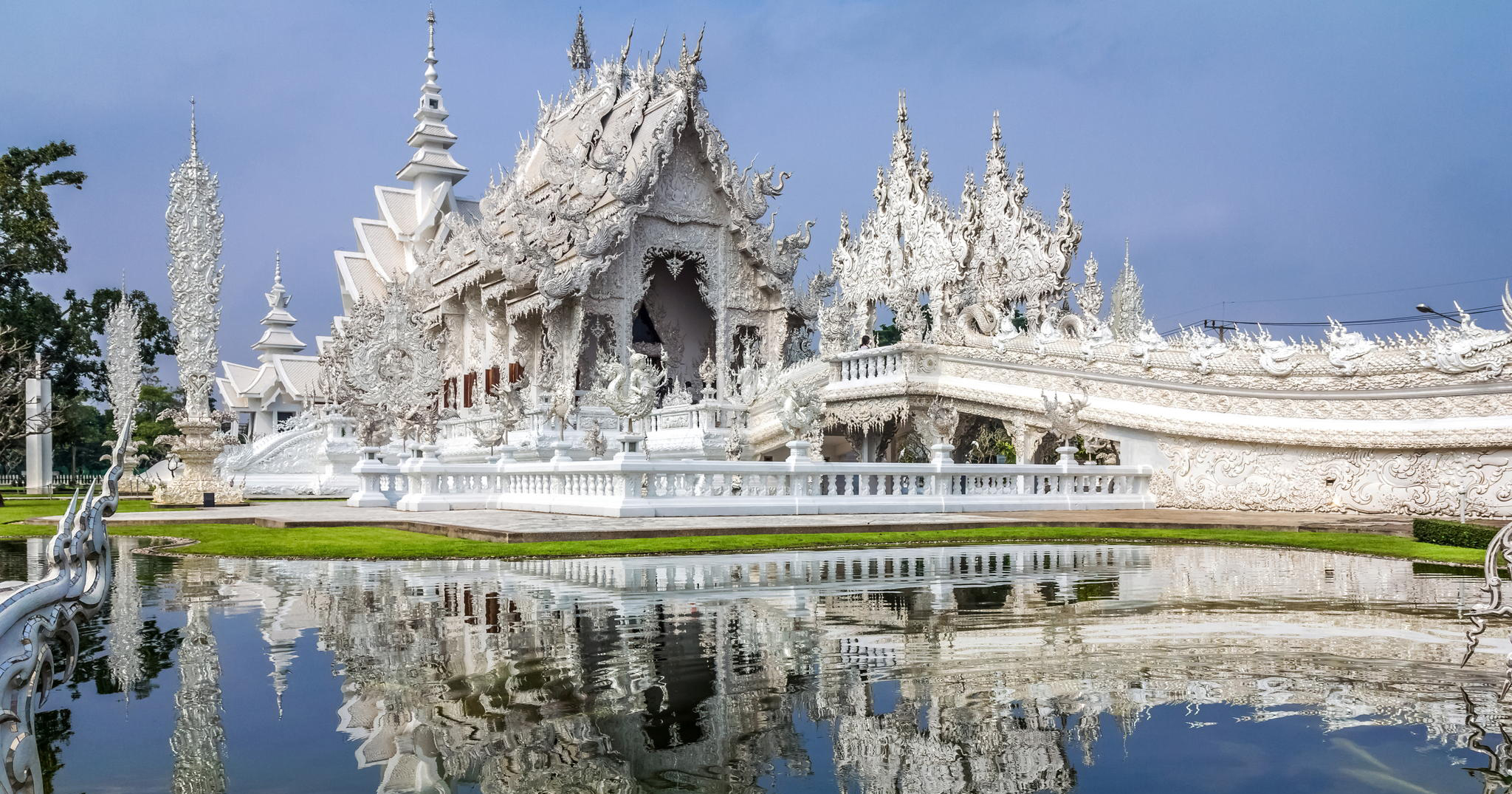
White with embedded mirrors, the exterior is a riot of intricate carving. Surrounded by a small moat, one first crosses hell with hundreds of arms extending up through the water.
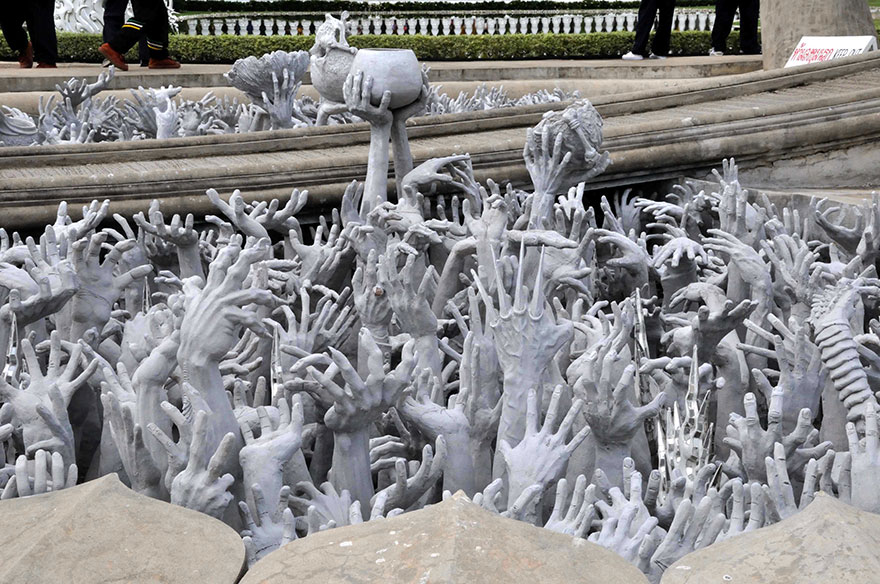
The inside of the temples is intricately painted with modern scenes depicting many pop icons. The eyes of the image opposite the Buddha image depicted evil with George W Bush and Osama bin Ladin forming the pupils. All Thai temples have gold stupas but here only the toilets were gold.
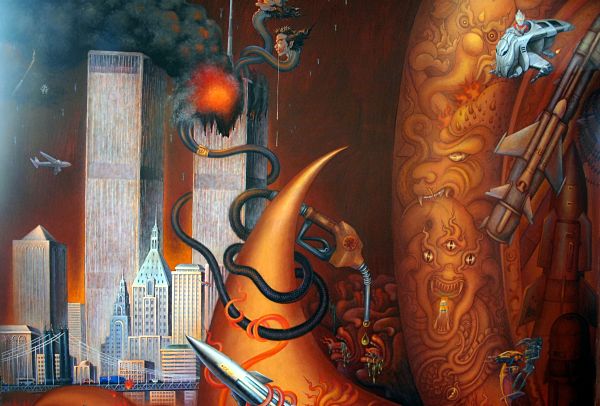
The Black House would have been virtually impossible to find without a guide. Built by another Thai artist as a maze of art galleries, it showcases his eclectic collection of massive solid teak tables, furniture built with animal skulls and horns, and a collection of python skins. The massive teak building is an architectural delight. The Monkey Cave is a huge limestone cave with expansive views and monkeys. Joe was constantly treating us with ice cream, corn and then lunch in an endlessly big market.
The afternoon was spent in the Golden Triangle, the infamous area of Northern Thailand, Myanmar, and Laos where most of the world’s opium and heroin came from. In Thailand, with rigorous policing, opium has been completely replaced with other crops and tourism as a source of income. The main tourist area gives views over the area formed by the Mekong and one of its tributaries. The House of Opium has good displays of the cultivation, harvesting and smoking of the drug. The Teak Temple is an ancient prang/stupa in a forest of teak trees.
Even though it was dark, we visited a free hot springs provided by the city of Chiang Rai for its residents. A thoroughly enjoyable day.
On to Laos. After the 2-hour bus ride to Chiang Khong on the border, we learned that the old border crossing using a boat to cross the Mekong had been replaced and this was the first day (December 12th) for the new bridge crossing. A 10 km tuk-tuk ride brought us to Thai immigration, followed by a bus ride across the bridge, and then a visit to Laos Immigration near Huay Xai. Confusion reigned as the new system was tested.
BANGKOK April 9-14
I never thought I would be back in Bangkok but here I am for the fourth time this winter. My original flight home was Bangkok-Narita/Tokyo-Vancouver and as I had time, I decided to see Taiwan, S Korea and Japan in the last seven weeks of my 2014 winter and then cancel the first leg of my flight home. Unfortunately, airlines do not let you do that and cancel the entire flight. So I flew from Tokyo to Bangkok and then back to Tokyo. This is the hottest part of the year in Bangkok with high humidity. I stayed in one of my favourite hostels anywhere – Lub’d Silom.
Wat Traimit in Chinatown shelters a 3m tall, 5.5-ton solid gold Buddha image. Cast 700 years ago, it was covered in plaster for centuries and discovered accidentally in 1954. A magnificent building has been recently constructed to house it. It can be disassembled into nine pieces. At US$1,400 per troy ounce, the gold in the statue (18 karat) is estimated to be worth 250 million dollars. The body of the statue is 40% pure, the volume from the chin to the forehead is 80% pure, and the hair and the topknot, weighing 45 kg, are 99% pure gold.
Across the river is Wat Arun is covered with porcelain tiles left behind by Chinese merchant ships no longer needing them as ballast.
I then spent a few days relaxing and doing several chores. Thailand New Year started on April 11th and lasts 2 weeks. The first 3 days are Songkran, the water festival. Everyone has a water pistol and big barrels of water line the sidewalks. Buckets and hoses are everywhere and most people are soaked as everyone is fair game.

